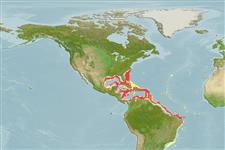Environment: milieu / climate zone / depth range / distribution range
Ecology
Marine; bathydemersal; depth range 180 - 2000 m (Ref. 53012). Deep-water
Western Atlantic: Florida, off the the Greater Antilles, Barbados, and off Belize to Rio Grande do Sul, Brazil.
Size / Weight / Age
Maturity: Lm ? range ? - ? cm
Max length : 12.0 cm SL male/unsexed; (Ref. 53012)
Visually orienting ambush predator (Ref. 53012).
Life cycle and mating behavior
Maturities | Reproduction | Spawnings | Egg(s) | Fecundities | Larvae
Distinct pairing (Ref. 205).
Munroe, T.A., 2003. Paralichthyidae. Sand flounders. p. 1898-1921. In K.E. Carpenter (ed.) FAO species identification guide for fishery purposes. The living marine resources of the Western Central Atlantic. Vol. 3: Bony fishes part 2 (Opistognathidae to Molidae), sea turtles and marine mammals. (Ref. 53012)
IUCN Red List Status (Ref. 130435)
Threat to humans
Harmless
Human uses
Tools
Special reports
Download XML
Internet sources
Estimates based on models
Preferred temperature (Ref.
123201): 5.2 - 13.9, mean 8.2 °C (based on 218 cells).
Phylogenetic diversity index (Ref.
82804): PD
50 = 0.5000 [Uniqueness, from 0.5 = low to 2.0 = high].
Bayesian length-weight: a=0.00741 (0.00325 - 0.01693), b=3.15 (2.97 - 3.33), in cm total length, based on LWR estimates for this Genus-body shape (Ref.
93245).
Trophic level (Ref.
69278): 3.4 ±0.5 se; based on size and trophs of closest relatives
Resilience (Ref.
120179): High, minimum population doubling time less than 15 months (Preliminary K or Fecundity.).
Fishing Vulnerability (Ref.
59153): Low vulnerability (10 of 100).
